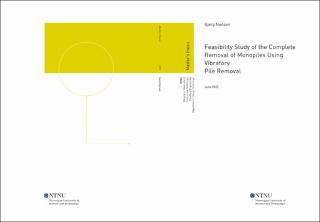| dc.description.abstract | The offshore wind market is a fast growing market. Currently, 3 GW of offshore wind are installed
in The Netherlands. However, the ambitions of the Dutch government are to have 30 GW offshore
wind installed by 2030. The current installed offshore wind capacity of Europe is 28 GW. The
EU ambitions are to install 60 GW by 2030 and to install 300 GW by 2050. Wind farms are
designed to have a lifetime of 20 to 25 years. When wind turbines reach their end-of-life, they
have to be decommissioned. The already installed capacity and the enormous amount of turbines
that are to be installed in order to reach the offshore wind ambitions, eventually all have to be
removed. To date, only a hand full of offshore wind farms have been decommissioned. This is due
to the fact that not many wind farms have reached their end-of-life. The most used technique is
partial removal, where a cut is made at a few meters below the mudline and the top part of the
monopile is removed from the marine environment. However, this method leaves a significant part
of the monopile in place after decommissioning, leaving behind tonnes of steel in the subsurface.
Completely removing the monopile from the marine environment can be done by using vibratory
pile removal. By modelling the forces and limits involved in vibratory pile removal, an estimation of
the diameters up to which vibratory pile removal is technically feasible has been done. In addition,
the costs and CO2-eq. emissions have been modelled and examined. The opposed method uses
vibration to reduce the soil resistance along the shaft of the monopile by creating soil fatigue. With
the currently available tools, it is possible to extract monopiles up to a diameter of approximately
5.8 meters in clay and up to approximately 7.9 meters in sand. For a mixed soil profile, it is
likely that the limit lays with these two numbers. Likely, it is possible to extend these limits by
developing more powerful tools or by internally dredging the monopile before using vibratory pile
removal. By retrieving extra steel from the soil by choosing complete removal over partial removal,
more steel can be recycled. This leads to an extra emission reduction of approximately 100 to 830
mT CO2-eq. per monopile, dependent on the diameter and the type of connection between the
transition piece and the monopile. Whether complete removal is preferred from a economic point of
view is dependent on the type of connection between the transition piece and the monopile and the
diameter. Based on the results found during this research in can be said that all wind farms that
reach their end-of-life up to 2039 can be decommissioned using vibratory pile removal. Dependent
on the soil type of the subsurface, even wind farms reaching their end-of-life up to 2045 can be
removed using vibratory pile removal. In many cases complete removal should be preferred over
partial removal based on both economic and environmental grounds. In some cases a cost benefit
analysis should be made in order to determine whether a higher reduction of CO2-eq. emission is
worth the extra costs involved in completely removal a wind farm with vibratory pile removal. | |
